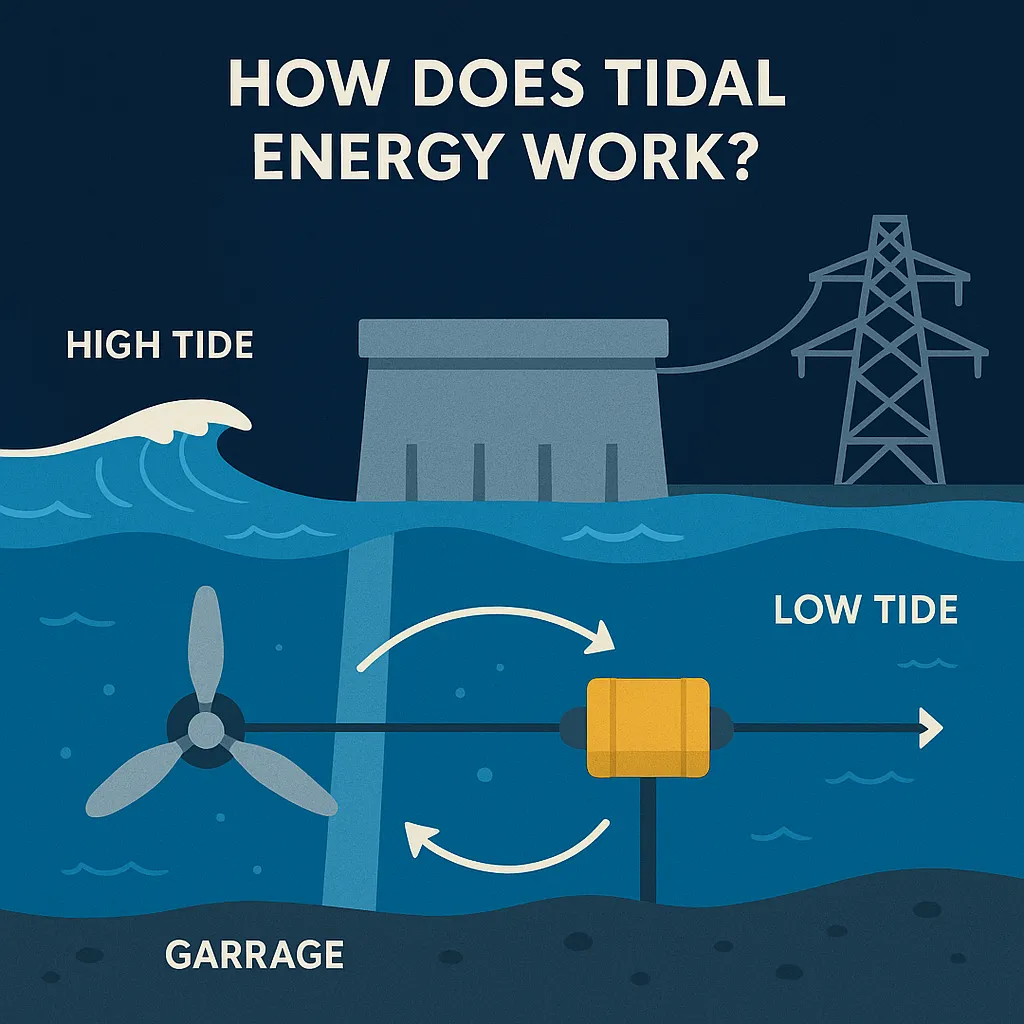Tidal power harnesses useful electricity from the natural ebb and flow of ocean tides. Earth’s oceans experience the gravitational forces of the sun and moon, which create these tides.
Sea levels rise and fall in repeated cycles, allowing huge volumes of water to enter and leave coastal areas. Energy travels with that movement, and we can harness it using the right technology

The Role of Gravitational Pull and Tidal Cycles
The moon affects the tides the most. It pulls water on Earth towards it through its gravitational force, which forms the high tide. On the other side of the Earth, there is another high tide due to inertia, and the spaces between have low tides.
The cycles of the tides repeat twice a day and are perpetual, so tidal energy is one of the most predictable forms of renewable energy.
This predictability is a major reason why tidal power is becoming popular. In contrast with solar or wind, which rely on weather conditions and daylight, tidal currents can be predicted years ahead of time, making it easier for grid managers to plan energy delivery more predictably.
Capturing Tidal Energy from Moving Water
Tidal motion is converted into electrical power by harnessing the kinetic and potential energy of flowing water. There are two primary ways to harness this energy:
1. Tidal Stream Systems:
These function similar to wind turbines in water. Giant turbines are mounted on the ocean floor where there is quick tidal flow. When water rushes past the blades as the tide moves back and forth, it turns them around.
That mechanical motion is transferred to a generator, which generates electrical power. The water density allows even slow flows to create impressive energy.
2. Tidal Barrages:
A tidal barrage is a dam constructed across a tidal bay or estuary. It retains water at high tide and lets it out at low tide. Turbines incorporated into the structure rotate as the water flows in and out, similar to a hydroelectric dam. Others produce electricity on both incoming and outgoing tides, which is more efficient.
Both systems use the movement of water against turbines. The turbines convert mechanical energy into electrical energy via generators. The energy, like electricity from other sources, is transferred to power grids.
Supporting Systems and Energy Conversion
Modern tidal power systems consist of sensors, controllers, and power converters. These assist in controlling how and when turbines are operated, depending on the intensity and time of tides. Power conditioning gear converts the output for safe and efficient supply to the grid.
Most of the power generated is alternating current (AC), the same as that supplied in homes and offices. In certain offshore installations, energy may be transferred in the form of direct current (DC) and then converted into AC prior to supply.
Site Selection and System Placement
Tidal power schemes work only in places where tidal range or current is strong. Careful site assessment is therefore necessary before the installation of turbines or barrages.
Best locations are narrow coastal channels, bays, or estuaries, where tidal flow is magnified. Nations with extensive coastlines and high tidal range, such as the UK, Canada, and South Korea, are at the forefront of development in this field.
Summary
Tidal power harnesses the predictable motion of ocean water that is caused by the force of gravity. Turbines installed in the water—or integrated into barrages—harvest this motion and translate it into electricity using generators. Since tidal cycles are reliable, the energy output is predictable and reliable.
As long as the moon keeps orbiting the Earth, tides will keep flowing—and with proper infrastructure, they can continue to power houses and businesses with clean, renewable electricity.
In order to provide a clear and understandable explanation of tidal energy, I conducted research using a number of reliable sources, including the MAERSK TRAINING and the PACIFIC NORTHWEST NATIONAL LABORATORY.
Posted by Abu Talha
With a background in science at the A-level, Abu Talha has studied subjects including physics, chemistry, mathematics, and biology. Along with his more than 1.5 years of experience in digital marketing, he is passionate about writing about electric vehicles, sustainable energy, and how emerging technologies are influencing the future.
